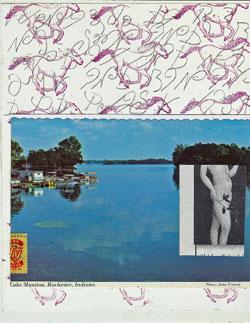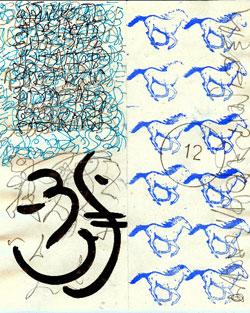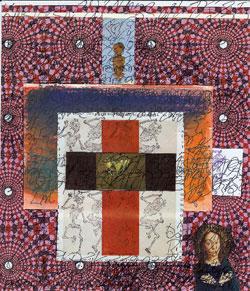Theme Essay by Theresa Williams
Letters, Longing, and Imagination
I go online. I post about myself, my pets, my publications, discover I’ve been tagged, tag others.
 I come away fragmented. I come away feeling like I’ve been sitting in the shallow end of a swimming pool, refreshed but not quite. I never got my head wet—or my shoulders or my chest.
I come away fragmented. I come away feeling like I’ve been sitting in the shallow end of a swimming pool, refreshed but not quite. I never got my head wet—or my shoulders or my chest.
I’ve filled my mind to bursting with facts, but what was really gained? I hardly got beyond my own empty talk. I never made it to my core, to a center that throbs, to my secret heart.
I’ve heard it argued that the Internet is a good way for artists to communicate, and it does present opportunities that can’t easily be found elsewhere. But I don’t think social networking and email are an adequate substitute for the personal letter.
Like cursive writing, the letter—on paper, sent through the post—is ostensibly on its way to extinction. I don’t understand why. Perhaps more than any other form of correspondence, the personal letter arises from a deep need to communicate with another person. This is its most touching aspect and why so much is at stake.
In her fabulous 1938 book If You Want to Write, Brenda Ueland tells the story of Vincent Van Gogh, an art-loving clergyman’s son in his early twenties, living in England, drawn to the downtrodden and hoping to work with the church. Ueland sees in Van Gogh’s early letters a hint of the creative impulse to come:
He had no thought of being an artist at all. He sat in his cheap little room writing a letter to his younger brother in Holland, whom he loved very much. He looked out his window at a watery twilight, a thin lamppost, a star, and he said in his letter something like this: ‘It is so beautiful I must show you how it looks.’ And then on his cheap ruled notepaper, he made the most beautiful, tender, little drawing of it.
When we create art, says Ueland, it’s as though “a live, alternating current is passing swiftly between teller and listener.” The same happens when we write personal letters.
Perhaps flesh-and-blood listeners aren’t necessary to make art. They might be imaginary, transcendent, no longer living. But I’ve come to believe, with Ueland, that the best art happens when—as with Vincent’s descriptive words and lovely drawing in his letter to his brother Theo—it’s created with a specific listener in mind.
• • •
When I’m online, people I barely know share their headaches and heartaches with the world. I listen. I commiserate. But in doing so, I learn next to nothing about myself.
 So easy, this losing of myself in the all-consuming appetites of others. So easy, this losing of myself altogether.
So easy, this losing of myself in the all-consuming appetites of others. So easy, this losing of myself altogether.
The Internet is engineered to suck us in, to light the addiction centers in the brain. Like all addictions, it can remove us from the unpleasant realities of life. Its vastness promises flight, departure, escape.
And therein is the problem. Artists—writers—aren’t supposed to forget the abyss. Though they may tiptoe around it, they’re meant to gaze into it now and then.
James Wright, while still a young man and years from his Pulitzer Prize in poetry, explored his deepest self in his personal letters. In them, one feels his longing for connection. As he wrote to his former classmate Susan Lamb:
Do you see? Do you understand? I love it, the whole wild, senseless, confused, dying mess of my life, and I don’t even know why.
He touches his own heart, and, I imagine, hers, when he writes:
I must write now to someone, not concerning anything in particular, but only for the sake of pouring, pouring, pouring.
The Internet has the advantage of speed, and speed can take us far, but it doesn’t necessarily take us deep. We humans aren’t like computers; we can’t retrieve knowledge at so many gigabytes per second. An insight might take years to arrive at. And while electronic correspondence might even be good for pouring, pouring, pouring, it’s not very good for digging, digging, digging.
A personal letter may be written in a quick burst of inspiration, but it may also evolve over hours, even days. It’s rare to dally over electronic communication. We all know the feeling as our hands flutter over the keys, the moment of tension as a finger poises over “send,” the feeling of release that follows, the pleasure of anticipatinga prompt response.
Letters take longer. Letter writers lose focus. The environment always intrudes. Undone tasks taunt. Children cry for milk. The belly churns. Neighbors scream through walls. But there’s something to be said for taking time, for waiting. Letters and longing go hand in hand. Longing titillates the imagination.
Maybe Van Gogh would have realized his love for the things of this world even without having written his personal letters. Maybe Wright would have still won the Pulitzer Prize for his poetry. But the fact that they were both compulsiveletter writers is significant.
What we find in the personal letters of both men is the soul igniting, trying to make itself understood to another human being. In time, both men achieved this magnificent experience through their art, but it was a long journey. While writing their letters, while reaching out to those trusted listeners, these artists encountered personal truths that later found expression in their art.
• • •
Writing letters has always seemed natural to me.
Lately, my love of letter writing has resulted in an ongoing collection of epistolary poems, “the eternal network.” The collection started in the summer of 2011 as I was writing a letter to a former student, Jim Lampe, a letter that became a piece called “olympia, dear jim.”

I’ve often wondered why we don’t value personal letters in the same way we value poems, essays, stories; why we don’t publish them in our literary magazines. And why isn’t more being done to encourage their survival?
These questions have been on my mind for some time. In answer, I started The Letter Project, a blog dedicated to encouraging and preserving personal correspondence. The project, begun in 2009, includes epistolary works and mail art by people at my own university as well as from around the world.
The looming death of the personal letter feels like the diminishing of the rainforest—we may never have a full understanding of everything we’ve lost. The personal letter remains the domain of the soul. It offers us an avenue for exploration. It gives us time to gather thoughts, a workable form, and an occasion for creating.
I can’t imagine why anyone would want to give that up.
Publishing Information
- Brenda Ueland. If You Want to Write: A Book about Art, Independence and Spirit. Saint Paul:Graywolf Press, [1938] 1987.
- James Wright. A Wild Perfection: The Selected Letters of James Wright. Edited by Anne Wright and Saundra Rose Maley. New York: Farrar, Straus & Giroux, 2005.
- Theresa Williams. “olympia, dear jim.” Infinity’s Kitchen, September 2011.
- The Letter Project
Notes on the Mail Art Images Used with this Essay
- "Lake": An unpublished piece sent to Patricio Duprat. The work that goes with it, “the eternal network: ii. 18 July,” was published in Twelve Stories on November 7, 2011.
- "Blue Horses": First published in Peripheral Surveys in August 2011, along with a poem about Emily Dickinson.
- "Madonna": First published in Danse Macabre in September 2011, along with a story called "The Ghost." It was originally sent as mail art to Cheryl Penn of South Africa.
 Theresa Williams is a contributing writer at Talking Writing.
Theresa Williams is a contributing writer at Talking Writing.
"The stories I wrote about my experience with depression were not just for myself but also for others who might need them. I knew then that this is why we must be fearless about sharing our experiences." — "Lawrence's Apples"
